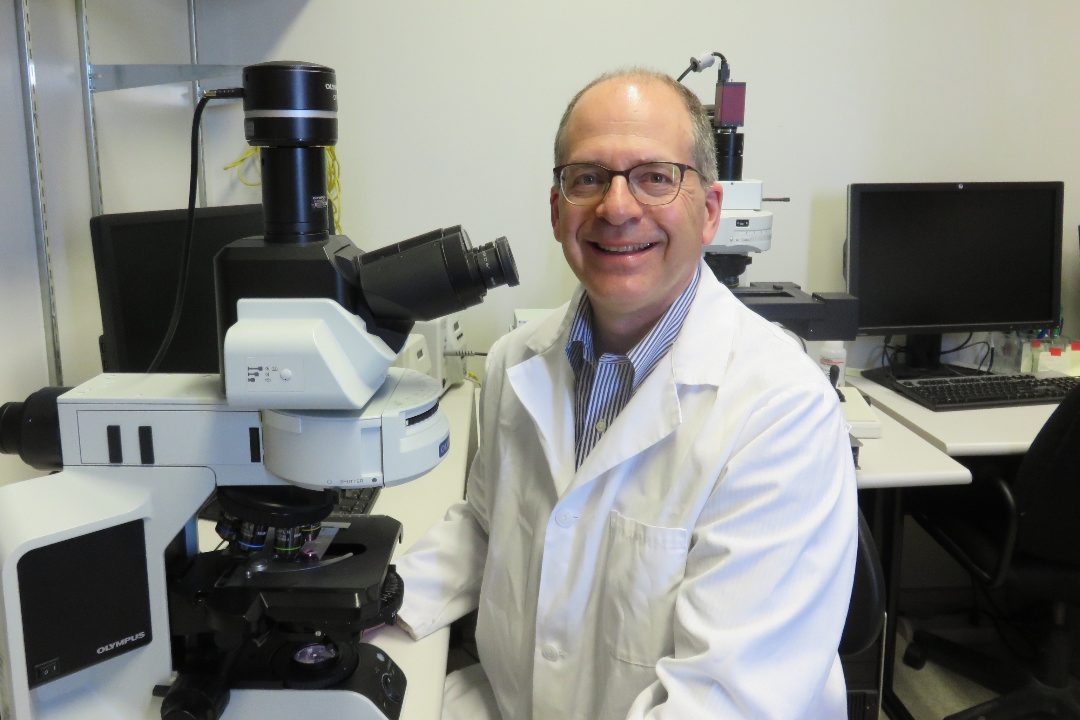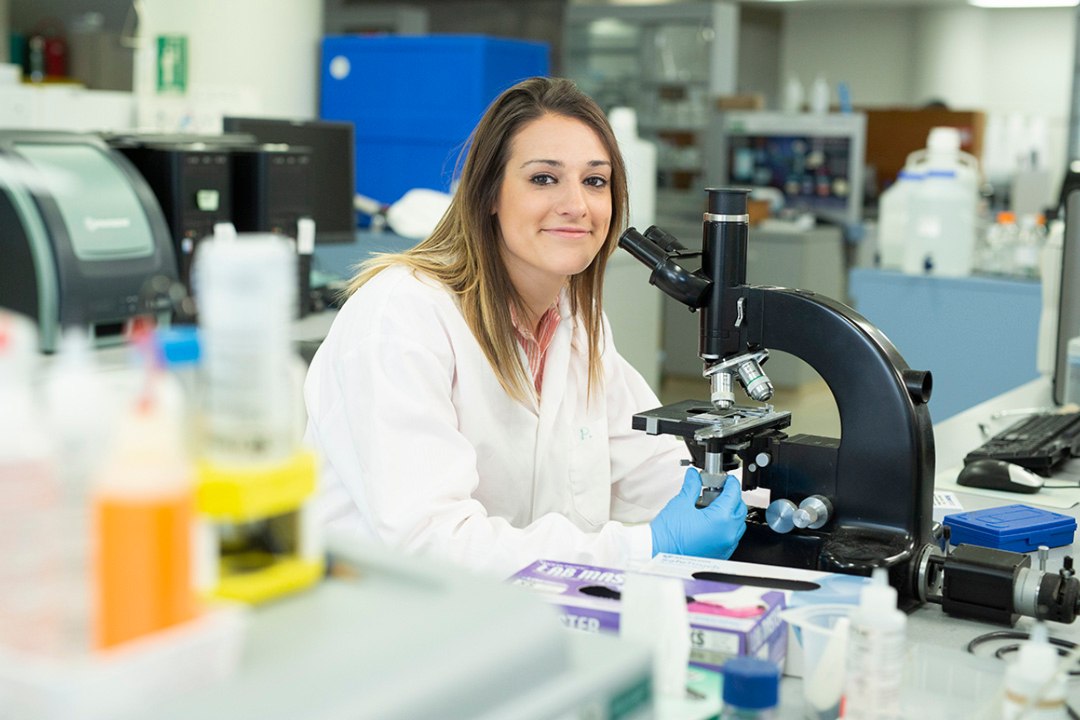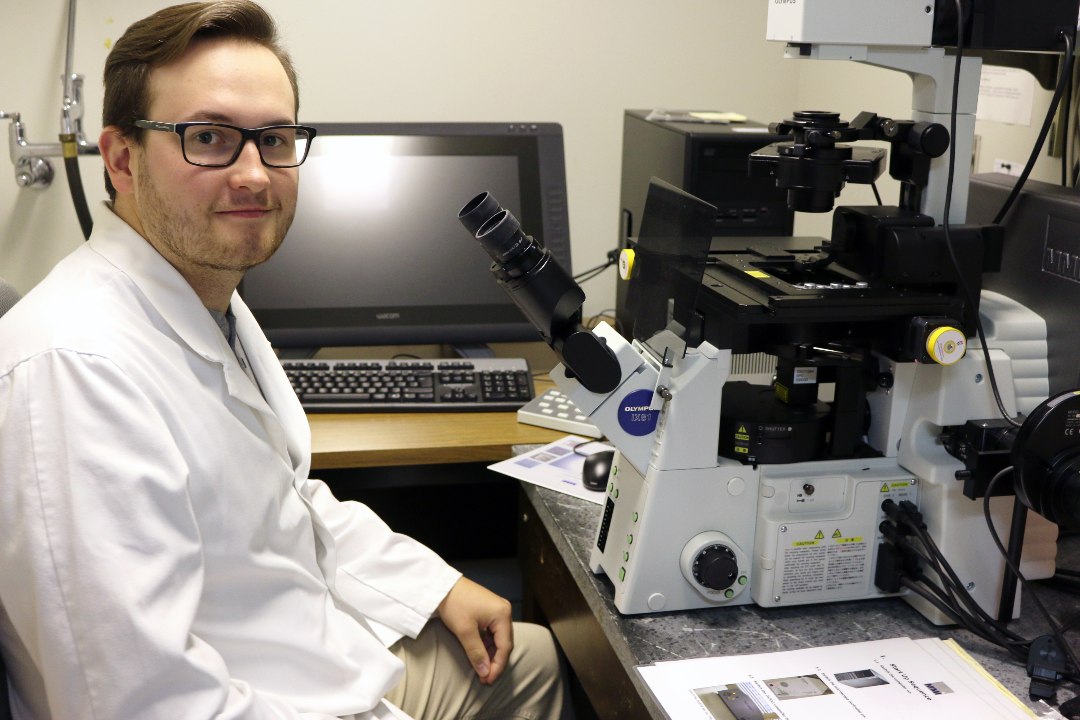
Nerve cell damage control
Every disease has a burning question, and multiple sclerosis (MS) is no exception. Researchers at the University of Saskatchewan take an innovative and collaborative approach to solving the enigma of disease progression in people living with MS – and how it can be slowed or stopped.
By Globe and Mail: Innovation Excellence ReportCanada has one of the highest rates of MS, with an estimated 90,000 of Canadians living with the disease, yet “although we’ve come very far in the last 20 years in treating MS and reducing attacks of neurologic function, we still see people decline,” says Michael Levin (MD), professor in the College of Medicine, University of Saskatchewan, and the Saskatchewan MS Clinical Research Chair. “This raises the question of why people with MS get worse. After looking under the microscope at brains from MS patients, we now know one reason why.”
MS is characterized by inflammation in the central nervous system. The resulting damage to nerve cells in the brain and the spinal cord leads to physical and cognitive impairment, and Dr. Levin explains that there are three components at play in this process.
“Firstly, MS is an inflammatory disease where the immune system, rather than protecting us, attacks the brain and spinal cord,” he says. “The second is known as demyelination, where myelin, the protective coating surrounding nerve cells, which allows them to work together efficiently, is degraded. The third component of MS relates to the nerve cell, which becomes injured and dies over time, in a process known as neurodegeneration.”
Many studies have confirmed the contribution of these three components – inflammation, demyelination and neurodegeneration – in MS, but Dr. Levin emphasizes that it is “the neurodegeneration that correlates most strongly with people getting worse. We know from MRIs, MS brain tissue and clinical studies that nerve cell injury plays a critical role – yet none of the current MS therapies are designed to protect nerve cells from damage.”
Targeting the inflammatory aspect of MS, currently prescribed medications dampen the immune response, he says. “While it makes sense to prevent the immune attack on the brain and spinal cord, we still see nerve cell damage, even in people living with MS who are on these therapies.”
A novel approach to treating MS
To address this conundrum, Dr. Levin and his team take a different approach: they focus on protecting nerve cells from damage.
One key insight arrived when Hannah Salapa (PhD), professional research associate, Office of the Saskatchewan MS Clinical Research Chair, noticed nerve cells malfunction related to heterogeneous nuclear ribonucleoprotein A1 – or A1 for short – in MS. “In control cases without MS, A1 is primarily found in the nucleus. In MS, A1 may start out in the nucleus and then gradually be localized – or become stuck – in the cytoplasm. When A1 is absent from the nucleus, it can no longer perform its functions and the nerve cell starts to get injured.
“From seeing this in one or two cases, we were able to replicate it to confirm it was definitely related to MS,” she says. “When we observed this in a high number of cases, we decided it was important to investigate further. So we used an animal model that mimics some features of MS, called experimental autoimmune encephalomyelitis, where we found the same pathology as in humans.”
The findings confirmed that A1 plays a critical role in the health of a nerve cell: normal A1 location in the nucleus equates to a normal, healthy nerve cell, Dr. Salapa says.

From studying nerve cells in both experiments and autoimmune encephalomyelitis MS patients at autopsy, the researchers found that in people with MS, “A1 was not only stuck in the cytoplasm – it was malfunctioning,” says Dr. Levin. “This affects some of the most basic biology of a nerve cell, where A1 controls how RNA works.”
What makes these discoveries so important is that A1 – as an RNA-binding protein – controls “everything about RNA, and this is a hot topic in neurological disease,” says Dr. Levin, adding that these insights may provide clues not only for MS but also other neurological disorders, including amyotrophic lateral sclerosis (ALS). “Most MS research is focused on the immune system. We’re the first lab to show that RNA-binding proteins play a major role in how nerve cells are injured in MS.”
From discovering this mechanism for nerve cell injury and death, the team set out to find a way to halt this process, “either by preventing A1 from getting stuck in the cytoplasm or by preventing it from leaving the nucleus altogether,” says Dr. Levin. “Typically, A1 shuttles between the nucleus and the cytoplasm.”
This led the researchers to explore ways of designing drugs that bind A1, with one idea looking to prevent A1′s tendency to “clump together,” he explains. “Our theory was that if we have drugs that prevent A1 from clumping together in the cytoplasm, it can find its way back into the nucleus, where it can function normally and prevent nerve cell injury.”
Collaborative efforts
Since taking an idea to the point of impact – in this case to the development of effective therapies – “takes a lot of work,” Dr. Levin says the team enlisted help. “We reached out to collaborators from the University of Waterloo, who are using some of the most advanced computers in Canada to create three-dimensional molecular models of A1. We are also working with a chemist at the University of British Columbia, who sent us dozens of compounds that are potential candidates for making these drugs.”
The compounds went to Dr. Cole Libner (PhD), who is now a medical student in USask’s College of Medicine. He tested them with his team using in-vitro and in-vivo experiments.

“First, we grow nerve cells in a dish. Then we expose these cells to stress to introduce certain features of MS. We see A1 dysfunction where it gets stuck in the cytoplasm just like in MS and nerve cells becoming damaged,” says Dr. Libner. “Then we expose the cells to these new small molecule therapies and observe them under the microscope.”
The idea was to find out whether A1 would return to the nucleus. “And sure enough, we found that many of these small molecule therapies were beneficial to restoring the processes of these nerve cells,” he explains. The compounds that showed the biggest impact were then applied to experimental autoimmune encephalomyelitis, where the team simulated the internal environment of an MS patient’s body in mice, administered the new drugs and then monitored clinical symptoms, especially the paralysis that is typically associated with disease progression.
“Looking at the nerve cells under the microscope helps us determine which drugs are the most effective in preventing paralysis. Again, we’re seeing positive results so far. These molecules seem to be reducing the severity of the disease in mice as well as correcting A1 localization within nerve cells,” says Dr. Libner.
Most of the MS research and clinical care led by Dr. Levin is conducted at the Saskatoon City Hospital, which hosts the Cameco MS Neuroscience Research Centre, a 6,000-square-foot, open-concept research facility that is linked to the MS clinic and the MS rehab centre.
“One insight we learned from this process is that we can’t do it alone. The work – including at the microscopic level and in animal models – is very complex, and one person simply doesn’t have all the required expertise,” says Dr. Levin. “While 90 per cent of what we do happens here in our lab in Saskatoon City Hospital, at USask, we collaborate with colleagues from across the country and around the world.”
Innovation ecosystem

Baljit Singh, vice-president research at USask, regards this collaborative approach as a prime example of how innovation can be unlocked. “Innovation is about changing the way we look at something, about bringing a new perspective,” he says. “When we approach things differently, we can innovate.”
What aides this process of innovation is bringing diverse views and expertise to the table, and “that’s where teams, universities or societies that are multicultural or multidisciplinary have a natural advantage,” Dr. Singh explains. “We are trying to be more intentional in the way we foster innovation, including by encouraging the type of learning and research that brings together diverse perspectives.”
The idea is to create an ecosystem that is conducive to coming up with novel approaches, methodologies and insights, he notes. “Innovation can slow down when we become too comfortable with the status quo.”
Cross-disciplinary collaboration can happen organically – for example, when researchers seek out experts from different disciplines, different universities or different countries – but Dr. Singh says this can also be encouraged; for example, through funding support that requires partnership components.
“A lot of the big research projects at the University of Saskatchewan – for example, in food security, water security and health – require expertise from multiple disciplines,” he says. “I’ve also found that people get excited when they have an opportunity to bridge the impact of their discipline, when they are gaining new perspectives for moving forward.”
A combination of several factors has contributed to “interdisciplinarity being a way of life at the University of Saskatchewan,” he says. “One relates to our location in the middle of the country, some distance away from other major urban centres, so we had to work together and come up with a system where we have an impressive range of disciplines present on our campus.”
This culture of collaboration has made USask a sought-after partner for joint efforts, including with communities who seek support for addressing specific needs, with national organizations requiring certain research expertise or for international endeavours looking to “solve some of today’s most complex and pressing concerns,” says Dr. Singh. “Our world-leading research infrastructure also helps to attract collaborators.”
One such facility is the Canadian Light Source, the country’s only synchrotron facility, which uses different kinds of light to illuminate what happens at the molecular level. “Working with the Canadian Light Source enabled us to understand how these drugs are successful in binding A1 in three dimensions,” says Dr. Salapa, who adds that USask facilities have also provided services related to “advanced RNA-sequencing techniques.
“This allowed us to develop novel pipelines for analyzing some of the data,” she says. “Everyone is really open to collaboration – and happy to help push this project forward.”
Accelerating impact
The team’s promising findings have inspired ambitious goals. “I would like to see these therapies in safety trials in humans in about three years, and this would be considered rocket speed, since such things typically take five to seven years,” says Dr. Levin. “There are still many steps to take, but we have a clear pipeline now – and we’re looking at investing in automation to speed up part of the process.”
There is a sense of urgency: “Patients are impatient – and I am impatient. I’m at the stage in my career where I want to go forward as quickly as possible, especially since MS incidence is increasing, both in Canada and worldwide,” notes Dr. Levin.
“Our therapies have the potential to help MS patients who can’t be treated with immunosuppressant drugs. We also believe preventing nerve cells from being injured can benefit all people with MS,” he says, adding that this powerful potential has attracted significant funding support, including from USask, the Consortium of Multiple Sclerosis Centers, Saskatoon City Hospital Foundation, the Saskatchewan Health Research Foundation and MS Canada.
“What we are working on is a completely new strategy for how to treat MS,” says Dr. Levin. “Our efforts really resonate both across the world and at home in Saskatchewan, where everyone knows someone with MS since we have one of the highest incidence rates.”
The team’s promising findings have inspired ambitious goals. “I would like to see these therapies in safety trials in humans in about three years, and this would be considered rocket speed, since such things typically take five to seven years,” says Dr. Levin. “There are still many steps to take, but we have a clear pipeline now – and we’re looking at investing in automation to speed up part of the process.”
There is a sense of urgency: “Patients are impatient – and I am impatient. I’m at the stage in my career where I want to go forward as quickly as possible, especially since MS incidence is increasing, both in Canada and worldwide,” notes Dr. Levin.
“Our therapies have the potential to help MS patients who can’t be treated with immunosuppressant drugs. We also believe preventing nerve cells from being injured can benefit all people with MS,” he says, adding that this powerful potential has attracted significant funding support, including from USask, the Consortium of Multiple Sclerosis Centers, Saskatoon City Hospital Foundation, the Saskatchewan Health Research Foundation and MS Canada.
“What we are working on is a completely new strategy for how to treat MS,” says Dr. Levin. “Our efforts really resonate both across the world and at home in Saskatchewan, where everyone knows someone with MS since we have one of the highest incidence rates.”
Together, we will undertake the research the world needs. We invite you to join by supporting critical research at USask.
Article re-posted on .
View original article.
